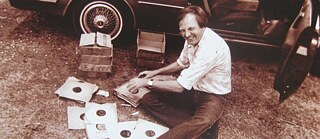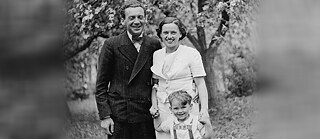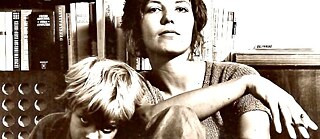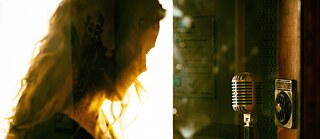Records that Shaped Lives
The Passion of Chris Strachwitz
Chris Strachwitz is a man possessed. A “songcatcher,” capturing and recording the traditional, regional, down-home music of the U.S. where he and his family settled after World War II.
Listen to this episode: Apple Music | Spotify | Download
This radio portrait is by The Kitchen Sisters, Davia Nelson and Nikki Silva. The duo produces audio series for NPR, including “The Keepers” and “Hidden Kitchens.” In this musical episode, Davia interviews record producer Chris Strachwitz of Arhoolie Records and a number of talented musicians, including Linda Ronstadt, Bonnie Raitt, Clifton Chenier, Johnny Clark, and Flaco Jimenez. John Fago took the featured photo, which shows Chris Strachwitz sorting through vinyls. In addition to this episode, Davia Nelson and Nikki Silva produced the episode “Dieter Kosslick’s Last Red Carpet Ride.”
Music:
“You’re No Good” by Linda Ronstadt
“I-Feel-Like-I’m-Fixin’-To-Die-Rag” by Country Joe and the Fish
“I Want to Be Alone with Mary Brown” by Al Starita & the Piccadilly Players
“Tin Roof Blues” by Albert Burbank & Kid Ory
“Berliner Luft” from the operetta Frau Luna, composed by Paul Lincke, 1904
“Alma Linda” by Leo Garza y su Conjunto
“Mi Unico Camino” by Conjunto Bernal
“Milk Cow Blues” by Maddox Brothers and Rose
“Have you Ever Loved A Woman” by Lightning Hopkins
“Come Back Baby” by Mance Lipscomb
“Tom Moore Blues” by Mance Lipscomb
“Write Me A Few of Your Lines” by Mississippi Fred McDowell
“You Got to Move” by Mississippi Fred McDowell
“Grand Texas” by The Hackberry Ramblers
“Zydeco Sont Pas Sale” by Clifton Chenier
“Ay, Ai Ai” by Clifton Chenier
“Charlie James” by Mance Lipscomb
“The Ballad of Gregorio Cortez” by Los Pinguiños del Norté
“Cancion Mixteca” by Ramiro Cavazos & Rafael Ramîrez
“Jesus Will Fix It” by Sonny Treadway
Transcript
Davia Nelson: Chris Strachwitz is a man possessed. A songcatcher — capturing and recording the traditional, regional, down-home music of America, his adopted home after his family left Germany at the close of World War II. Chris Strachwitz is a keeper. His vault is jam-packed with 78s, LPs, 45s, reel-to-reels, cassettes, videos — an archive of all manner of recordings and an avalanche of lifetime achievement awards — from the Grammys, The Blues Hall of Fame, The National Endowment for the Arts — for some 60 years of recording and preserving the musical cultural heritage of this nation. For THE BIG POND, The Kitchen Sisters present: The Passion of Chris Strachwitz.
Chris Strachwitz: Alma Latina was the name of the club. It was a wonderful dance hall. There were young kids there, there were old people, middle age. It was a colorful place. But I had a hell of a time recording that conjunto. The two guys sang into one microphone. Thank God, they’re not like hippies all have to have their own damn microphone. It’s a rough recording, but goddamn, we caught it.
Linda Ronstadt: Chris Strachwitz first of all is very tall, eagle nose which makes him look wise and learned, which is mainly opinionated. He can back his opinions up with a lot of information that he’s acquired over the years, especially about blues and ethnic music like Mexican music that comes out of Texas. It’s got a German base to it which gave him points in my book, because I’m Mexican-German. I always say that Germans came to Mexico and Mexico took German music and made it sexy.
[MUSIC: YOU’RE NO GOOD, LINDA RONSTADT – LIVE AT CENTER STUDIOS]
He’s deeply suspicious of all music that’s layered like oil paintings, the kind of music that I make, and pop music in general, but we’re working on educating him about that. I don’t know if it’ll ever happen since he’s now what, 80? 87. I don’t think it’s going to change his opinion, but we’re still working on him. I’m Linda Ronstadt, Tucson, Arizona.
[MUSIC: YOU’RE NO GOOD, LINDA RONSTADT – LIVE AT CENTER STUDIOS // MI UNICO CAMINO – CONJUNTO BERNAL]
Chris Strachwitz: My name is Chris Strachwitz. I was born in a little village in Lower Silesia, southeast of Berlin in 1931. We had a very large farm. It was the kind of a castle, I guess you could say, in the little village. We were part of the aristocracy. I was called a Count von Strachwitz. [MUSIC] I just had an incredibly wonderful childhood. Private tutors, woods and forests, ideal for hunting deer and pheasants and rabbits and wild boar. There was constant hunting parties.
[MUSIC: I WANT TO BE ALONE WITH MARY BROWN – THE PICCADILLY PLAYERS, 1928]
When my parents came back from a trip to the United States in 1938, they brought back a bunch of records. I thought they were just neat objects. I collected coins, I collected stamps, too. I thought they were just a window to the world. And records were a window to sounds that I never would have heard. [MUSIC: BERLINER LUFT] There was a wonderful record that we had in our wind-up machine called Die Berliner Luft. [CHRIS SINGS:] ‘O wie schön ist die Berliner Luft Luft Luft, die Berliner Luft Luft Luft …’ Anyway, it came from an operetta. One day my father walked into the room and he said, ‘Christian you can’t listen to that record anymore.’ And I said, ‘Why? I love it, it’s such a neat song. It’s got such a great feeling, a joy to it.’ — ‘Well, the composer is a Jew. If the Nazi leader here in the village hears about us playing Jewish music he can give me all kinds of static.’
[MUSIC: PSALOM – KRONOS QUARTET]
The Allies won the war. Stalin and Roosevelt and Churchill met to decide what to do about dividing up Germany to reward the countries that won the war. The Soviet Union desperately wanted a big piece of Germany. And in late winter of 1945 we had to flee before the Russians came because we were considered capitalists. We knew that the Soviet army that was invading that part of Germany was not particularly obeying the rules of war, and I can’t blame them one bit considering what Germany did to the Soviet Union, I mean almost destroyed the whole country, you know. So, they got even, and they got a big chunk of Germany. I still visualize how we left that day, we were all stashed into this wagon with the tractor in front. We could already hear the shooting across the Oder River. I didn’t know where we were going. We were loaded down with whatever we could carry which was things that we could eat, you know. That image is still pretty strong with me. Our mother’s mother had been an American, and her aunts were so keen to immediately after the war help us and try to get us out of Germany. My father had to stay behind, he had to be de-Nazified because he had been the member of the party. Although I never heard him speak fondly of Hitler or anything. It was strictly like here, being a Republican. Well, you know you’re for big business, you better join the National Socialist German Workers Party, the Nazis. My mother and six of us children came in 1947 to our great aunt in Reno, Nevada.
[MUSIC: MILK COW BLUES – MADDOX BROTHERS AND ROSE]
I was 16. I had hardly had much schooling from 45 to 47. I spoke relatively little English. I was listening to the radio, that was really my ear to the world, and I heard Hillbilly Music, oh God I thought this was the neatest sounding music I’d ever heard. The station in Rosarito Beach in Baja California was beamed north. They call itself ‘The Voice of the West. This is the Maddox Brothers and Rose coming your way on XERB.’
[MUSIC: MILK COW BLUES – MADDOX BROTHERS AND ROSE]
I was sent to the Cate School in Santa Barbara. It was a very elitist private high school. I was so skinny they called me ‘the pencil’. I would sneak sometimes off during our break and run to my room and turn on XERB. [ARCHIVAL: XERB] And that had that Mexican DJ, you know, absolutely alive. He would broadcast in English. It was all hillbilly records. And I actually sent an application to the radio station saying ‘What does it take to become a disk-jockey on XERB?’ And they actually answered back, saying ‘Well, the first requirement is that you be a Mexican national.’ [LAUGHS] Well that kind of shot it down right there. So I got into hillbilly music and jazz. I’d heard that The Kid Ory Band was playing in Montecito in a small club so I just took off, hitchhiked. But I couldn’t get in because I wasn’t old enough. And so I stood outside and listened to the band. And then when I came back to school, Mr. Cate chewed me out. I was in a way shy, but in other ways I wasn’t. If I wanted to hear something I felt like, if I wanted to do something I did it. I just had to hear that music.
[ARCHIVAL: LET’S GO A-HUNTIN’ WITH HUNTER]
I was listening to Hunter Hancock’s program over KFVD in Los Angeles. By the mid 50s I was a total Lightnin' Hopkins fan. It's the same radio station that Woody Guthrie played on back in the 30s.
[MUSIC: HAVE YOU EVER LOVED A WOMAN – LIGHTNIN’ HOPKINS]
When I went to UC Berkeley in ‘54, I had met Sam Charters. Sam was working on this book, The Country Blues, it was the very first Blues book. I got a postcard from him: ‘Chris, I found Lightnin’ Hopkins. He lives here in Houston, Texas.’ And so I literally took a pilgrimage, took a Greyhound to Houston and Mac McCormick took me to meet Lightnin’ at just a little beer joint, you know. Lightnin’ was singing this amazing blues just totally made up on the spot about how it had been raining and how his shoulder was aching and how his car almost didn’t get there because he couldn’t see the chuckholes in the road. But he rhymed it all up and then he pointed his hand ‘oh this man came all the way from California just to hear po’ Lightnin’ sing.’ Mac said you have a car and you’ve got your recorder. Why don’t we go up the country and see if we can find ... there must be a lot of these singers like Lightnin’. I said I better start doing some detective work. And I saw people in a field next to the highway, so we stopped. ‘Do you know of any good guitar pickers in these parts?’ — ‘Oh … well you better go to Navasota for that.’
[MUSIC: TOM MOORE’S BLUES – LIGHTNIN’ HOPKINS]
All I had was a record by Lightnin’ about Tom Moore’s Farm. And Tom Moore actually lived in this town. It’s a pretty powerful song:
It ain’t but the one thing this black man done wrong.
But moved his wife and family on Mr. Tom Moore’s Farm.
So we stopped at the first feed store we saw. ‘Does Tom Moore live in this town?’ — ‘Yes, Mr. Moore sure does.’ He invited us to come to his office. Mac right away said, ‘Well can we possibly visit your plantation? Do you know of anybody who plays for your hands here in town?’ Tom Moore said, ‘I don’t know his name but you can go to the railroad station and ask Peg Leg.’ And it wasn’t hard to find Peg Leg. And he said, ‘Yeah his name is Mance Lipscomb.’
[MUSIC: COME BACK BABY – MANCE LIPSCOMB]
The first recording was made of Mance Lipscomb right in his little house in Navasota. It was a shotgun house where they slept in the back. That was the very first record I put out. I had recorded people before then, but I’d never done much with it, it was just a hobby. I had cheap tape recorders, I was just fishing in the dark, trying to get my ears.
[MUSIC: COME BACK BABY – MANCE LIPSCOMB]
Mance Lipscomb was really much more than a blues singer. When I first heard him I thought he is kind of a nice old guy who sings a lot of songs. But he didn’t have that ferocity that Lightning had or that low down-ness at all. He was a real gentleman. He started off with something like ‘Shine on Harvest Moon.’ Well that is the white folks like. But then Mac asked him ‘Have you ever heard this song about Tom Moore?’ — ‘Well, yes Sir I know that song but I don’t want you to put that on my record while I’m alive.’
[MUSIC: TOM MOORE’S FARM – MANCE LIPSCOMB]
That’s how I got to hear what a songster Mance Lipscomb really was. And he called himself that, he didn’t call himself a blues singer at all. And that’s why we called the first record Mance Lipscomb Texas Sharecropper and Songster. After Mac said, you know this is really the roots of all this stuff, this will be the record like Leadbelly was for Lomax. This will be your introduction to Arhoolie Records.
[BONNIE RAITT SINGS ‘WRITE ME A FEW OF YOUR LINES’: WHEN YOU GET HOME, BABY RIDE ME A FEW YOUR LINES. GETTING YOU HOME, BABY. WRITE ME A FEW YOUR LINES. THAT’LL BE CONSOLATION, BABY, ON MY WORRIED MIND.]
Bonnie Raitt: I’m Bonnie Raitt. I don’t remember exactly when I met Chris, but I know that it was through Mississippi Fred McDowell. Fred McDowell was one of my absolute favorite artists. And Arhoolie Records was the way that I heard about Fred.
[MUSIC: WRITE ME A FEW OF YOUR LINES MISSISSIPPI – FRED MCDOWELL]
Chris Strachwitz: In the 50s there was a recording made by Alan Lomax, and the one that just hit me was Fred McDowell playing Write Me a Few of Your Lines. He starts it real slow and then speeds it up. It was just the most amazing performance I had ever heard in my life.
[MUSIC: WRITE ME A FEW OF YOUR LINES MISSISSIPPI – FRED MCDOWELL]
I wrote to Alan: ‘Where is this man from?’ And he actually sent me a letter back saying Fred McDowell lives in Como, Mississippi, and he gave me the route. I drove up to Como into the farmyard, and there he was just getting off a tractor. He was such a wonderful person. He immediately invited me in — ‘Oh, yeah, you like my music.’
[MUSIC: YOU GOTTA MOVE – MISSISSIPPI FRED MCDOWELL]
They actually had me stay there that night, they let me stay in their bed. They slept on the couch. I’ll never forget what we had for breakfast too: eggs and white bread with some molasses. Yeah he made that whole record that first night.
[MUSIC: YOU GOTTA MOVE – MISSISSIPPI FRED MCDOWELL]
❡
Linda Ronstadt: I bought an Arhoolie record when I was sixteen years old. It was one of the first folk music records, The Hackberry Ramblers. I’m Linda Ronstadt, I was interested in traditional music. Arhoolie had the really rough stuff, you know, that was like Alan Lomax.
Bonnie Raitt: Arhoolie Records, it was just like a calling card for me. The stamp of approval. By the time Chris signed these people or went there and had the passion about them – Norteño, Tejano, Tex-Mex music, Delta Blues people, the Savoy Family, I mean I learned so much about those kinds of music because of Arhoolie Records.
Chris Strachwitz: This is Chris Strachwitz again. We’re at the little kitchen dining room in the little house next to the Arhoolie building, which also contains the Arhoolie Foundation and the Down Home Music Store as well as Les Blank Films Incorporated in Mighty El Cerrito right in the East Bay.
[MUSIC: FEEL LIKE I’M FIXIN’ TO DIE RAG – COUNTRY JOE MCDONALD]
This building I acquired not too long after we had that big hit with Country Joe doing ‘Feel like I’m Fixin’ to Die Rag.’ It came out in the movie, and I had some money. Ed Denson who had helped me start Tradition Music Company, he called me one evening, 1964, and he said: ‘Chris! You still have your tape machine ready? We got to record this song that this fellow I know here, he’s got a little trio here. It’s against the Vietnam War. We got to get this thing recorded so we have it ready for the big peace march.’ I finally said all right, bring them over and in walked this motley crew of hippies. The main man was a guy named Joe McDonald. And I hung the only omni-directional mic I had from the ceiling on my lamp, and I put them in a circle around the mic like that’s how I recorded J. E. Mainer’s band in 63. And they did 10 takes of ‘One, two, three. What are we fighting for? Next Stop is Vietnam. I don’t give a damn …’, you know, it was an amazing song! As they walked out he asked me ‘What do we owe you for the tape Chris?’, and I said ‘You don’t owe me nothing’. I asked them ‘Can I have the song for my newly formed Tradition Music Company?’ And he said ‘Go ahead, do that!’ It was a verbal agreement. Some years ago, Country Joe came to me and he said, ‘Chris don’t you think you made enough money off of me now?’ And I said, ‘Yeah okay, Joe, you’re good socialist. If you want it back, I’ll give it back to you.’ I thought that was a fair thing to do.
Archival interview: Live and Direct from the Studios of KPFA, I’m talking to the man himself who just about invented zydeco music. When I first heard you, I think Lightnin’ took me over to hear you. Because Lightnin’s wife, she’s a relative to you, isn’t she?
Clifton Chenier: Yeah, a second cousin.
Chris Strachwitz (archival): She said ‘Oh, he’s just playing at this little French club …’
Chris Strachwitz: We went to French Town in southeast Houston. There was this lanky black man with an accordion on his chest singing the most low-down blues, but in this weird French patois.
Chris Strachwitz (archival): When you grew up, there weren’t really any black guys playing this kind of French music, were there?
Clifton Chenier: Well, they had some older people playing it, but in a different style. What I did, I put a little rock into this French music.
Chris Strachwitz (archival): You were really the first guy to do that, to put a kind of rhythm and blues feeling into French music. How did you get that idea to mix the French music, which was really just waltzes and two-steps, you know, and mix that with rhythm and blues?
Clifton Chenier: Well, you see, in 1955 I used to play nothing but rock music on the accordion …
Chris Strachwitz (archival): Clifton Chenier and his Red Hot Louisiana Band they’re going to be playing tonight a dance in San Francisco at All Hallows Church Gymnasium that’s located in the Hunters Point area of San Francisco.
Clifton Chenier: We’re gonna rock ‘em all night long.
Johnny Clark: I would listen to Chris’s radio show on KPFA, particularly for the blues, but he would slip in Mexican stuff, like Los Pingüinos and things like that. And the German-type oom-pah-pah bands of Texas. Since it was Chris playing, I thought ‘Oh hey I better give this a listen.’ My name is Jonathan Clark, I collaborated with Chris on a series called Mexico’s Pioneer Mariachis.
Chris Strachwitz (archival): Flaco Jimenez, first of all, where does your nickname come from?
Flaco Jimenez: Well, Flaco means slim or skinny, you know.
Chris Strachwitz (archival): I guess, was your father fairly slender too? I have some records where he’s called El Flaco …
Chris Strachwitz: The first Mexican recordings: I met this guy Rumel Fuentes who was working with farm workers in the Rio Grande Valley. I usually traveled with my machines always at the ready. I met Rumel. And he got all ‘Oh yeah, just great, you want to record some Corridos,’ that’s how he got me hip to these Corridos, ballad songs, you know. He said ‘Oh there’s this wonderful little duet … they’re called in Piedras Negras, Coahuila, they’re called Los Pingüinos del Norte.’ I said ‘Well, the name is wonderful already, the Penguins of the North.’ They were all real cheerful and they were dressed like penguins, they had black pants on, a white shirt. Playing in these bars with all these local Corridos.
[MUSIC: CORRIDO]
A Corrido is a narrative ballad that tells real true stories. I really have a thousands, I would say. They became popular during the Mexican Revolution when people like to find out how this general died, he was very brave. This is all oral. This is vernacular music.
Linda Ronstadt: He really gets Mexican music. The heart and soul of it. The naughty little secret of me, I don’t speak Spanish very well either. I learned a lot of those songs just phonetically. I knew them as a little child growing up and didn’t know what they meant at all but just loved them and felt the passion in them. And he was able to do that. Maybe it’s a German thing, it just hits you like a ton of bricks. Especially things like longing … migration across the border to come up here, the ache and despair of homesickness and the feeling of utter desolation that they really understood in Chulas Fronteras, a movie they made. And the ‘Canción Mixteca,’ which is kind of the theme song of the immigrants. It's a beautiful song about being feeling like a leaf in the wind.
[MUSIC: CANCIÓN MIXTECA]
Chris Strachwitz: By the time I had some money I wanted to make a film about this Mexican border music. Nobody was paying any attention to this music I was becoming totally addicted to. Les Blank was doing a lot of interesting documentaries, he did that Lightnin’ film, he did the Mance Lipscomb one. We drove in my little car all over South Texas; Ry Cooder came along. Ry Cooder had been caught by this mania too. The mania for the Corridos took us into the fields. People were so nice, especially once they met a bunch of gringos who were into this, they always invited us, ‘Oh we’re going to have a Pachanga tonight, come on you guys,’ a party where you where you drink and sing and cook food …
Linda Ronstadt: His contribution has been to archive all this stuff that’s just never going to find its way onto the radio but needs to find its way to people’s ears. And has and inspired people like Ry Cooder, and the Savoy Family, Maria Muldaur, Bonnie Raitt. His archive has been essential for their careers. They take that root and they build on it in some kind of way that makes pop music, but pop music that’s firmly rooted into the soil. He calls stuff that he doesn’t like Mouse Music. It’s got no mojo to it, you know.
[MUSIC: CHARLIE JAMES – MANCE LIPSCOMB]
Chris Strachwitz: This is my ledger book, I thought I’d be pretty uptown and try to keep track of what I was recording once I got really into making records. This is all 60, Alex Moore and Butch Cage and Mance Lipscomb back again in August, Black Ace, Los Gatos, Big Joe Williams. In 61, okay, I’m back down in Texas here. I was just a lone cat. I never felt I really wanted to be tied down. I was really perfectly happy to be by myself, really. The only one I got totally enamored with was this young lady in Stuttgart, she worked for a German jazz magazine. We went on a trip, and when I came back, I said ‘sorry, I have to be by myself.’ She was totally in to modern jazz which really wasn’t my cup of tea at the time but she took me to hear John Coltrane at the Jazz Workshop on Broadway (in San Francisco), probably in 65. He had two drummers that night. And I’ll never forget it. It was the most amazing experience I’ve had in the jazz world. You were just engulfed in this rhythm machine.
[MUSIC: JESUS WILL FIX IT – SONNY TREADWAY]
Bonnie Raitt: The ripple effect of Chris Strachwitz in the world is immeasurable in preserving this music. I can’t even imagine what it would be like to not have heard those records. This music that without his care and watering would have withered probably. It didn’t matter what country he was from. This is somebody that was born to do this for the music that he loves.
Chris Strachwitz: What can I do?! Just do what you love to do. But you’ve got to make a living somehow. I got lucky. The Cate School, they actually gave me a placard, not too long ago, for what I accomplished in life. Nobody expected me to succeed, you know, I don’t think ... Mr Cate one time said to me, ‘I’ve heard that you really like some of this American music, and I want to tell you that back in the 40s a man came to the Mesa, he brought a large, black man with him. And the black man, he sang this amazing song about ‘Irene, Goodnight’.’ I said to Mr. Cate, ‘That must have been Leadbelly.’ — ‘Yeah I believe that was his name.’ And then I said, ‘And the man who brought him was probably Alan Lomax.’ — ‘Oh yes, it was Mr. Lomax who came to the Mesa and brought Leadbelly to perform.’ And I took that to heart. Many years later, I took Mance Lipscomb to the Mesa and I took Fred McDowell there, too. He was just amazed and so were the kids. They had never heard anybody like that. I figured if this is what Mr. Lomax did, I should continue.
[MUSIC: COME BACK BABY – MANCE LIPSCOMB]
Davia Nelson (credits): The Passion of Chris Strachwitz was produced by The Kitchen Sisters — Nikki Silva & Davia Nelson — for THE BIG POND. Mixed by Jim McKee. Produced in collaboration with Nathan Dalton and Brandi Howell. Deep bow to all the musicians heard in this story including Leo Garza y Su Conjunto, Linda Ronstadt, Conjunto Bernal, Maddox Brothers and Rose, The Piccadilly Players, Kronos Quartet, Albert Burbank & Kid Ory, Lightning Hopkins, Mance Lipscomb, Bonnie Raitt, Mississippi Fred McDowell, The Hackberry Ramblers, Country Joe and the Fish, Clifton Chenier and His Red Hot Louisiana Band, Los Pingüinos del Norte, Rafael Cavazoa and Rafael Ramirez and the sacred steel of Sonny Treadway. Most all the music in this story is from the Arhoolie catalog, which is now housed at The Smithsonian Institution and available from Smithsonian Folkways Recordings. The Smithsonian acquired Arhoolie in 2016, as Chris turned 85, helping to ensure that all the music he recorded and released would survive and remain available to future generations. Arhoolie is a part of the Smithsonian Folkways family of labels. Arhoolie recordings are available at Folkways.Si.Edu as well as your favorite record store and on all online platforms. Special thanks to Linda Ronstadt, Bonnie Raitt, Adam Machado, Maureen Gosling & Chris Simon, Huib Schippers, William Griffin and Jonathan Wiliger at Smithsonian Folkways — and to Chris Strachwitz, who lights the path.
For THE BIG POND, we’re The Kitchen Sisters.







